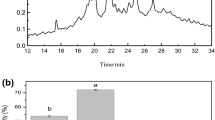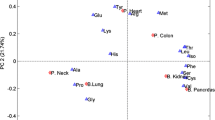Abstract
We evaluated the capacity of simulated gastrointestinal digests or alcalase hydrolysates of protein isolates from amaranth to scavenge diverse physiologically relevant reactive species. The more active hydrolysate was obtained with the former method. Moreover, a prior alcalase treatment of the isolate followed by the same simulated gastrointestinal digestion did not improve the antioxidant capacity in any of the assays performed and even produced a negative effect under some conditions. Gastrointestinal digestion produced a strong increment in the scavenging capacity against peroxyl radicals (ORAC assay), hydroxyl radicals (ESR-OH assay), and peroxynitrites; thus decreasing the IC50 values to approximately 20, 25, and 20 %, respectively, of the levels attained with the nonhydrolyzed proteins. Metal chelation (HORAC assay) also enhanced respect to isolate levels, but to a lesser extent (decreasing IC50 values to only 50 %). The nitric-oxide– and superoxide-scavenging capacities of the digests were not relevant with respect to the methodologies used. The gastrointestinal digests from amaranth proteins acted against reactive species by different mechanisms, thus indicating the protein isolate to be a potential polyfunctional antioxidant ingredient.
Similar content being viewed by others
References
Halliwell B, Gutteridge J (1999) Free rad in biology and med. Clarendon, Oxford
Kohen R, Nyska A (2002) Oxidation of biological systems: oxidative stress phenomena, antioxidants, redox reactions, and methods for their quantification. Toxicol Pathol 30:620–650
Noguchi N, Watanabe A, Shi H (2000) Diverse functions of antioxidants. Free Radic Res 33:809–817
Hartmann R, Meisel H (2007) Food-derived peptides with biological activity: from research to food applications. Curr Opin Biotechnol 18:163–169
Sarmadi B, Ismail A (2010) Antioxidative peptides from food proteins: a review. Peptides 31:1949–1956
Udenigwe C, Aluko R (2012) Food protein-derived bioactive peptides: production, processing, and potential health benefits. J Food Sci 77(1):R11–R24
Huerta Ocampo J, Barba de la Rosa A (2011) Amaranth: a pseudo-cereal with nutraceutical properties. Curr Nutr Food Sci 7:1–9
Tironi V, Añón M (2010) Amaranth as a source of antioxidant peptides. Effect of proteolysis. Food Res Int 43:315–322
Orsini Delgado M, Tironi V, Añón M (2011) Antioxidant activity of amaranth proteins or their hydrolysates under simulated gastrointestinal digestion. LWT Food Sci Technol 44:1752–1760
Martinez N, Añón M (1996) Composition and structural characterization of amaranth protein isolates. An electrophoretic and calorimetric study. J Agric Food Chem 44:2523–2530
Lowry O, Rosebrough N, Farr A, Randall R (1951) Protein measurement with the Folin phenol reagent. J Biol Chem 193:265–275
Ou B, Hampsch-Woodill M, Flanagan J et al (2002) Novel fluorometric assay for hydroxyl radical prevention capacity using fluorescein as the probe. J Agric Food Chem 50:2772–2777
Moore J, Yin Y, Yu L (2006) Novel fluorometric assay for hydroxyl radical scavenging capacity (HOSC) estimation. J Agric Food Chem 54:617–626
Hazra B, Biswas S, Mandal N (2008) Antioxidant and free radical scavenging activity of Spondias pinnata. BMC Complement Altern Med 8:63–73
Oliveira M, Minotto J, Oliveira M et al (2010) Scavenging and antioxidant potential of physiological taurine concentrations against different reactive oxygen/nitrogen species. Pharmacol Rep 62:185–193
Hughes M, Nicklin H (1968) The chemistry of peroxynitrites. Part I: kinetics of decompositions of peroxynitrous acid. J Chem Soc A:450–452
Possel H, Noack H, Augustin W, Keilhof G, Wolf G (1997) 2,7-Dihydrodichlorofluorescein diacetate as a fluorescent marker for peroxynitrite formation. FEBS Lett 416:175–178
Kooy N, Royall J, Ischlropoulos H (1997) Oxidation of 2′,7′-dichlorofluorescin by peroxynitrite. Free Radic Res 27:245–254
Nakajima A, Matsuda E, Matsuda Y, Sameshima H, Ikenoue T (2012) Characteristics of the spin-trapping reaction of a free radical derived from AAPH: further development of the ORAC-ESR assay. Anal Bioanal Chem 403:1961–1970
Ou B, Hampsch-Woodill M, Prior R (2001) Development and validation of an improved oxygen radical absorbance capacity assay using fluorescein as the fluorescent probe. J Agric Food Chem 49:4619–4626
Kim G, Jang H, Kim C (2007) Antioxidant capacity of caseinophosphopeptides prepared from sodium caseinate using alcalase. Food Chem 104:1359–1365
Samaranayaka A, Li-Chan E (2008) Autolysis assisted production of fish protein hydrolysates with antioxidant properties from pacific hake (Merluccius productus). Food Chem 107:768–776
Zhou K, Caning C, Sun S (2013) Effects of rice protein hydrolysates prepared by microbial proteases and ultrafiltration on free radicals and meat lipid oxidation. LWT Food Sci Technol 50:331–335
Silva F, O’Callagahan Y, O’Brien N, Netto F (2013) Antioxidant capacity of flaxseed products: the effect of in vitro digestion. Plant Foods Hum Nutr 68:24–30
Minetti M, Pietraforte D, Di Stazi A, Mallozi C (1996) Nitric oxide-dependent NAD linkage to glyceraldehyde-3-phosphate dehydrogenase:possible involvement of a cysteine thiyl radical intermediate. Biochem J 319:369–375
Ma Y, Xiong Y, Zhai J, Zhu H, Dziubla T (2010) Fractionation and evaluation of radical scavenging peptides from in vitro digests of buckwheat protein. Food Chem 118:582–588
Linxiang L, Abe Y, Kanagawa K et al (2007) Iron-chelating agents never suppress Fenton reaction but participate in quenching spin-trapped radicals. Anal Chim Acta 599:315–319
Mendis E, Rajapakse N, Byun H, Kim S (2005) Investigation of jumbo squid (Dosidicus gigas) skin gelatin peptides for their in vitro antioxidant effects. Life Sci 70:2166–2178
Zhong S, Ma C, Lin Y, Luo Y (2011) Antioxidant properties of peptide fractions from silver carp (Hypophthalmichthys molitrix) processing by-product protein hydrolysates evaluated by electron spin resonance spectrometry. Food Chem 126:1636–1642
Ewing J, Janero D (1995) Microplate superoxide dismutase assay employing a nonenzymatic superoxide generator. Anal Biochem 232:243–248
Moure A, Domínguez H, Parajo J (2006) Antioxidant properties of ultrafiltration-recovered soy protein fractions from industrial effluents and their hydrolysates. Process Biochem 41:447–456
Quansah J, Udenigwe C, Saalia F, Yada R (2013) The effect of thermal and ultrasonic treatment on amino acid composition, radical scavenging and reducing potential of hydrolysates obtained from simulated gastrointestinal digestion of cowpea proteins. Plant Foods Hum Nutr 68:31–38
Zhuang Y, Sun L (2011) Preparation of reactive oxygen scavenging peptides from tilapia (Oreochromis niloticus) skin gelatin: optimization using response surface methodology. J Food Sci 76(3):C483–C489
Acknowledgments
This work was supported by Agencia Nacional de Promoción Científica y Tecnológica (ANPCyT, Argentina) projects (PICT 2007–1114, PICT 2007–1119). Authors are members of CONICET (Argentina). Dr. Donald F. Haggerty, a retired career investigator and native English speaker, edited the final version of the manuscript.
Compliance with Ethics Requirements
ᅟ
Conflict of Interest
M. C. Orsini Delgado declares that she has no conflict of interest.
M. Galleano declares that she has no conflict of interest.
M. C. Añón declares that she has no conflict of interest.
V. Tironi declares that she has no conflict of interest.
This article does not contain any studies with human or animal subjects.
Author information
Authors and Affiliations
Corresponding author
Electronic supplementary material
Below is the link to the electronic supplementary material.
ESM 1
AAPH-derived radicals scavenging with preparations I (●), Id (○), H (▲) and Hd (∆). Panel a: the ORAC assay; Panel b: the ESR assay. (DOC 1520 kb)
ESM 2
Typical ESR spectra obtained for Panel a: PBN-adduct of AAPH-derived radicals, Panel b: DMPO-OH adduct. (DOC 457 kb)
ESM 3
Hydroxyl radicals inhibition with preparations I (●), Id (○), H (▲) and Hd (∆). Panel a: the HORAC assay; Panel b: the ESR assay. (DOC 1061 kb)
ESM 4
Scavenging % with preparations I (●), Id (○), H (▲), Hd (∆). Panel a: superoxide, Panel b: nitric oxide (DOC 338 kb)
ESM 5
Peroxynitrites scavenging with preparations I (●), Id (○), H (▲) and Hd (∆). (DOC 472 kb)
Rights and permissions
About this article
Cite this article
Delgado, M.C.O., Galleano, M., Añón, M.C. et al. Amaranth Peptides from Simulated Gastrointestinal Digestion: Antioxidant Activity Against Reactive Species. Plant Foods Hum Nutr 70, 27–34 (2015). https://doi.org/10.1007/s11130-014-0457-2
Published:
Issue Date:
DOI: https://doi.org/10.1007/s11130-014-0457-2




